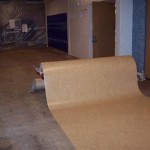Laying Wood Laminate Flooring: Choosing the Right Direction
Wood laminate flooring offers an attractive and cost-effective alternative to solid hardwood. Its durability, ease of installation, and variety of styles make it a popular choice for both residential and commercial spaces. One of the most crucial decisions to make before beginning a laminate flooring installation is determining the optimal direction in which to lay the planks. This decision affects the visual appeal of the room, its perceived size, and even the ease of installation.
The direction in which laminate flooring is laid can significantly alter the overall look and feel of a room. Understanding the principles of visual perception and considering the room's architectural features are essential for making an informed choice that complements the space and maximizes its potential.
Several factors contribute to the selection of the appropriate laying direction. These include the room's shape and size, the primary light source, the existing subfloor, and personal aesthetic preferences. A careful evaluation of each of these aspects will contribute to a successful and visually pleasing laminate flooring installation.
Understanding the Impact of Laying Direction on Room Perception
The orientation of laminate planks can dramatically influence how a room is perceived. Laying planks lengthwise, parallel to the longest wall, tends to elongate the space, creating an illusion of greater depth. This technique is often employed in narrow rooms or hallways to make them appear more spacious. Conversely, laying planks perpendicular to the longest wall can make a room appear wider. This approach is particularly beneficial in square or compact spaces where the goal is to enhance the sense of breadth.
In smaller rooms, laying the laminate flooring diagonally can add visual interest and create a sense of greater space. However, diagonal installations are more complex and often result in increased material waste due to the need for angled cuts. Careful planning and precise measurements are crucial for achieving a professional-looking diagonal installation.
The direction of the flooring also influences the flow of movement within the room. Laying planks in the direction of the natural path of travel can create a more cohesive and intuitive spatial experience. Consider the typical entry points and traffic patterns within the room to determine the most appropriate orientation for the flooring.
Considering the Light Source and Room Aesthetics
The primary source of natural light within a room should also be a key consideration when determining the laying direction of laminate flooring. Generally, it is recommended to lay the planks parallel to the primary light source, typically a window. This orientation allows the light to run along the length of the planks, highlighting the natural grain patterns and creating a more uniform and aesthetically pleasing appearance.
Laying planks perpendicular to the light source can result in more noticeable seams and a less consistent appearance. The light hitting the seams at an angle can create shadows, accentuating the individual planks and potentially disrupting the overall visual harmony of the floor. While this effect can be desirable in certain design contexts, it is generally advisable to align the flooring with the light source for a smoother and more polished look.
Beyond the light source, the overall aesthetic of the room should also influence the choice of laying direction. Consider the existing décor, furniture, and architectural features. The flooring should complement these elements and contribute to a cohesive and visually appealing design. For example, in a room with strong horizontal lines in the architecture or décor, laying the flooring horizontally can reinforce this theme and create a sense of continuity.
When installing laminate flooring in multiple rooms, it is common to maintain a consistent direction throughout the connected spaces. This creates a sense of flow and continuity, making the overall space feel larger and more integrated. However, there are situations where changing the direction from one room to another can be appropriate, particularly if the rooms have distinct functions or architectural styles. In such cases, a transition strip can be used to create a clean and visually appealing separation between the different flooring areas.
Technical Considerations and Installation Best Practices
While aesthetic considerations are paramount, technical factors also play a role in determining the optimal direction for laying laminate flooring. The subfloor, the surface directly beneath the laminate flooring, must be level, clean, and dry. Any imperfections in the subfloor can affect the stability and longevity of the finished floor. When installing laminate over a wood subfloor, it is generally recommended to lay the planks perpendicular to the floor joists. This provides added support and minimizes the risk of sagging or unevenness.
The expansion and contraction of laminate flooring due to changes in temperature and humidity must also be taken into account. Laminate planks expand and contract primarily along their width, so leaving an expansion gap around the perimeter of the room is essential to prevent buckling or warping. The size of the expansion gap typically ranges from ¼ to ½ inch, depending on the manufacturer's recommendations and the size of the room.
Proper installation techniques are crucial for achieving a professional-looking and durable laminate floor. This includes using the correct tools, carefully measuring and cutting the planks, and ensuring that the planks are properly interlocked. A tapping block and a pull bar are essential tools for engaging the locking mechanisms of the laminate planks without damaging them.
Furthermore, it is imperative to follow the manufacturer's instructions regarding the underlayment, which is a thin layer of material placed between the subfloor and the laminate flooring. The underlayment provides cushioning, sound insulation, and moisture protection. Selecting the appropriate underlayment for the specific type of laminate flooring and subfloor is crucial for optimizing the performance and longevity of the installation.
For rooms with irregular shapes or complex layouts, it may be necessary to make custom cuts and adjustments to ensure a seamless and professional-looking installation. Planning the layout carefully in advance and using a chalk line or laser level to guide the installation process can help to minimize errors and ensure that the planks are laid straight and evenly.
When encountering obstacles such as pipes, door frames, or heating vents, precise measurements and careful cutting are essential. A jigsaw or oscillating multi-tool can be used to make clean and accurate cuts around these obstacles. It is also advisable to use a sealant or caulk around pipes or other penetrations to prevent moisture from seeping under the flooring.
Proper acclimation of the laminate flooring prior to installation is another critical step. Laminate flooring needs to adjust to the room's temperature and humidity levels for a minimum of 48 to 72 hours before installation. This helps to minimize expansion and contraction after the floor is installed, reducing the risk of gaps or buckling.
Finally, maintaining a clean and organized work area is essential for a successful laminate flooring installation. Regularly sweeping or vacuuming the subfloor and the laminate planks helps to prevent dirt and debris from interfering with the installation process. It also makes it easier to spot any imperfections or misalignments before they become major problems.
In conclusion, selecting the appropriate direction for laying wood laminate flooring involves a combination of aesthetic considerations and technical factors. By carefully evaluating the room's size, shape, light source, subfloor, and personal preferences, it is possible to create a visually appealing and durable floor that enhances the overall look and feel of the space. Paying attention to installation best practices and following the manufacturer's instructions will ensure a professional-looking and long-lasting result.

Determining The Direction To Lay Install Hardwood Laminate Or Luxury Vinyl Plank Flooring

Which Direction To Lay Your Hardwood Flooring Riterug

Tips From The Table Laying Your Floor

Best Direction To Lay Laminate Flooring Make Your Floor Stand Out April 2024

How To Install Laminate Flooring With The Glueless Method Interior Design Wonderhowto

Which Direction Should The Floor Be Laid Real Wood Floors

Which Direction Do You Lay Vinyl Plank Flooring Google Search Laying Laminate Installing Bedroom

Which Direction To Lay Your Hardwood Flooring Riterug

Installing Laminate Flooring In Hallways Do It Yourself

How To Install Laminate Flooring For Beginners
Related Posts








